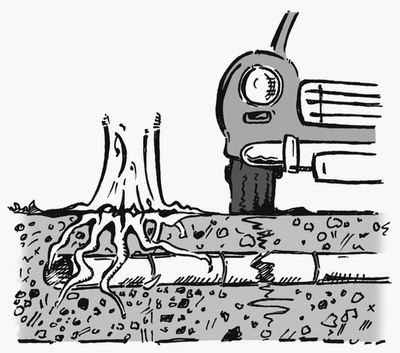System failure
If your effluent treatment and disposal system is used correctly and is well maintained, it should give many years of trouble-free service. However, neglect, damage and even long years of use can cause your system to fail.
How can you tell your system is failing?
If you notice one or more of the following, your system is probably failing and you must take urgent action to get it working properly again:
- Sinks and toilets are slow to drain;
- Your treatment system overflows, most likely from a vent, or there is an overflow occurring from a gully trap;
- You smell effluent near either the treatment system or disposal system;
- Black and slimy areas are forming on the ground where your disposal system is located;
- Your disposal area is on a slope and there is lush, dark green grass growth down the slope, particularly during summer; or
- Your system has mechanical pumps installed, such as an AWTS, and an alarm bell or light is going (a high effluent level warning system has been activated).
 Tree roots and cracked pipes can lead to system failure.
Tree roots and cracked pipes can lead to system failure.
Why do systems fail?
When an on-site effluent treatment and disposal system starts giving problems, it is usually because the disposal system has begun to fail. Failure of the disposal system can be caused by:
- A build-up of sludge in the septic tank.
If the septic tank is not pumped out often enough (see: Regular maintenance), excessive solids and fats may escape into the disposal system, causing it to clog and reduce the amount of effluent that can soak into the surrounding soil.
- Tree roots may extend into the disposal system and cause a blockage, preventing the effluent from getting all the way through the disposal system. This overloads a small part of the disposal system.
- Heavy stock or vehicles may fracture the disposal system.
This will also prevent effluent getting all the way through the disposal system and overloads a small part of it.
- Poor location of the disposal system in waterlogged areas where the effluent cannot soak into soil that is already wet.
- The ‘good’ bacteria in the treatment system have been ‘killed off’ by unsuitable materials being put down household drains.
- The distribution box has been damaged or not maintained so that effluent is not being evenly distributed to the entire disposal system.
Some other causes of system failure
Aerated Wastewater Treatment Systems (AWTS) and other mechanical treatment systems.
If the power supply to a mechanical treatment system is disconnected, then the effluent and air pumps will not operate. In the event of a power supply failure to the house, the occupants of the house should minimise the volume of effluent entering the system until the power supply is restored. This may not be an issue if water supply also requires a pump.
If excessive effluent does enter the system, there is the risk of effluent from the settlement chamber overflowing into other compartments. If this does occur, then the system may need to be desludged so that it operates correctly. Depending on the duration of the power failure, the lack of oxygen within the aerobic chamber may also result in the death of all the aerobic bacteria.
Effluent filters
An effluent filter has small holes that will eventually become clogged with natural organic growth, and the filter needs to be cleaned regularly to prevent this from happening. If there is an excessive amount of solids in the septic tank, or the tank is undersized, then it is likely that the filter will become blocked more frequently. If your filter does become blocked, effluent will build up within the tank and overflow through the vent or from the nearest drainage opening (e.g. a gully trap). If this does occur, have the septic tank desludged and clean the filter. Do not remove the filter completely, as the solids will then flow directly into the disposal system and cause it to fail.
Why is treatment system failure a problem?
- Effluent above the surface of the ground is a health hazard to your family, your pets and your neighbours.
- Birds, rats and other animals may spread disease from the effluent.
- A mosquito and fly breeding ground may develop.
- Your own or other people’s underground water supplies may be polluted.
- Streams, beaches and shellfish beds may be polluted.
